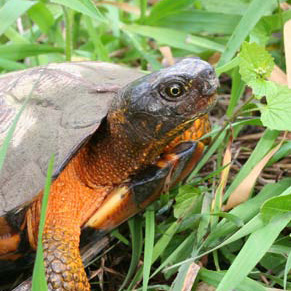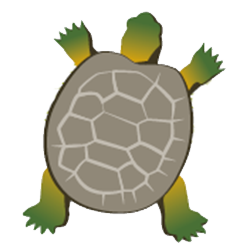Wood Turtle

Species description
The Wood Turtle (Glyptemys insculpta) is a rare, medium-sized turtle that can grow up to 25 centimetres in carapace (top shell) length. The species gained its name for the wooden-like appearance of its carapace, which is typically brownish-grey with rough concentric ridges and grooves, giving it the appearance of wood. Its head and legs are dark brown, with lighter underparts ranging from yellow to orange to red in colour. Wood turtles typically do not reach sexual maturity until they are at least 10 years of age and females, on average, only lay one clutch of 8-12 eggs per year. Like many turtle species, the Wood Turtle is a long-lived species, potentially reaching more than 50 years of age.
In Canada, the Wood Turtle can be found in Ontario, Quebec, Nova Scotia and New Brunswick. In Ontario, this species occurs in southern and eastern Ontario, as well as the area north of Lake Huron. The availability of suitable habitat for Wood Turtle is limited due to its specific habitat needs. The species requires areas with rivers and streams that have moderate current, sand or sandy gravel substrates, and a mix of terrestrial habitats, such as forests, meadows, and shrub thickets.
Wood Turtle faces numerous threats to its survival and recovery, including habitat loss or degradation of its aquatic and terrestrial habitats, collision with vehicles, collection for the pet trade, and nest predation by subsidized predators (e.g., skunks and raccoons). Since many roads in Ontario run parallel to rivers or streams, female Wood Turtles seeking nesting sites are particularly threatened by collisions with road vehicles; however, both sexes have been affected by road mortality from collisions with both on and off-road vehicles.
The survival and recovery of Wood Turtle are influenced by other factors as well. Because this species requires more than a decade to reach reproductive maturity, any individuals that die before this time are unable to contribute to the survival of the population. In addition, Wood Turtles experience low rates of recruitment, which means that populations cannot rebound from declines very quickly. Finally, the Wood Turtle is at the northern limits of its range in Ontario and variable weather may negatively affect nest success rates in a given year.
Wood Turtle is listed as endangered at the provincial level (Species at Risk in Ontario List) and is listed as threatened at the federal level (Schedule 1 under the Species at Risk Act). Globally, it is considered to be vulnerable.
Provincial status
Prior to the Endangered Species Act, 2007 (ESA or “the Act”) the Committee on the Status of Species at Risk in Ontario (COSSARO) assessed Wood Turtle as endangered. It was added to the Species at Risk in Ontario List as endangered in 2004, but was not regulated under the previous Endangered Species Act. The species retained its endangered status when the ESA came into force in 2008. In future assessments, COSSARO may consider information regarding the species’ threats and trends in population and distribution gained through protection and recovery actions.
Species and habitat protection
As an endangered species, all Wood Turtles have been protected from being killed, harmed, harassed, captured or taken since the ESA came into force in 2008.
In addition, the habitat of Wood Turtle has been protected from being damaged or destroyed since 2010, when the government developed a habitat regulation for the species.
Protecting Wood Turtle and enforcing the regulation protecting the specific habitat of the species are key components in the implementation of the ESA and continue to be government-led actions, as identified in the government response statement. As an endangered species, all Wood Turtles have been protected from being killed, harmed, harassed, captured or taken since the ESA came into force in 2008. In addition, the habitat of Wood Turtle has been protected from being damaged or destroyed since 2010, when the government developed a habitat regulation for the species. Prior to its transition to the ESA there was no species or habitat protection for Wood Turtle. Further information on species and habitat protection is provided in section 2.3 of the introductory chapter of this document.
Although the ESA does not require a habitat regulation to be developed for transition
Any person who negatively impacts Wood Turtle or its habitat without prior authorization may be prosecuted under the ESA.
Recovery strategy
A recovery strategy for Wood Turtle was completed on February 18, 2010, which was in advance of the date required by the ESA. It represents best science advice to government. The strategy identified the habitat needs of Wood Turtle and the threats that it faces, while recommending objectives and approaches for protecting and recovering the species. The recovery strategy also included recommendations on the areas of habitat to be considered in the development of a habitat regulation.
Government response statement
The Ministry of Natural Resources and Forestry (“the Ministry”) published the government response statement (GRS) for Wood Turtle on November 18, 2010, which was within the timeframe required by the ESA. The GRS is government policy that contains the Government of Ontario’s goal for the recovery of Wood Turtle.
Recovery goal
The government’s goal for the recovery of Wood Turtle is to halt the decline of the species in Ontario and to restore and maintain viable self-sustaining populations throughout their current provincial distribution.
To help achieve this goal, the government leads and supports a number of recovery actions. Common actions for the government to lead as it works towards achieving a species’ recovery goal are provided in section 2.5 of the introductory chapter of this document. Two specific actions for the government to lead to help protect and recover Wood Turtle are:
- Ensure appropriate timing windows for undertaking activities in and around Wood Turtle habitat are considered in the application of the ESA; and
- Encourage the submission of Wood Turtle data to the Ministry of Natural Resources and Forestry’s central data repository at the Natural Heritage Information Centre and ensure data sensitivity guidelines are put in place to improve information sharing as appropriate.
The GRS for Wood Turtle also outlines nine actions for which the Ministry is using a variety of methods to support others to undertake. These government-supported actions fall under the objectives identified in the GRS, which are:
- Reduce Wood Turtle mortality, illegal collection and other human-related threats to the species;
- Identify and protect existing Wood Turtle populations and their habitat throughout their current provincial distribution; and
- Increase awareness of Wood Turtles in Ontario.
The subsequent sections of this chapter provide a review of actions that the government has led or supported to help achieve the recovery goal for Wood Turtle.
Government funded projects
An important government-led action in the GRS for Wood Turtle is to support partners to undertake activities to protect and recover the species. Through the Species at Risk Stewardship Fund the Ministry has supported a total of 52 projects designed to contribute to the protection and recovery of Wood Turtle. Nine of these projects ($340,584) focused exclusively on the species, while the other 43 projects ($1,634,581) focused on multiple species at risk, including Wood Turtle. In addition to the funding provided through the Species at Risk Stewardship Fund, partners focusing exclusively on Wood Turtle reported that they were successful in securing additional funding and inkind support ($488,135) from other sources, as did partners with projects designed to benefit multiple species at risk, including Wood Turtle ($3,567,188). These values for additional funding and in-kind support include the estimated value of the time and expertise provided by volunteers, which are outlined below.
Stewardship partners also reported that the province’s funding support helped them to involve 51 individuals who volunteered 1,461 hours of their time toward protection and recovery activities that focused exclusively on Wood Turtle, which has an estimated value of $51,880. As well, a total of 3,446 individuals volunteered 31,201 hours of their time toward protection and recovery activities for multiple species at risk, including Wood Turtle, which has an estimated value of $745,800.
The Ministry’s stewardship partners reported that through both their efforts and the efforts of their volunteers to implement actions contained in the GRS, they were successful in enhancing 2,247 hectares of habitat that may benefit multiple species at risk, including Wood Turtle. In addition, stewardship partners reported providing focused outreach on Wood Turtle to 3,036 individuals, and ecosystem-based outreach on multiple species (including Wood Turtle) to 268,216 individuals.
Species at Risk Stewardship Fund
-
 $340,584
$340,584for Wood Turtle exclusively
-
 $1,634,581
$1,634,581for multi-species projects that included Wood Turtle
-
 $4,055,323
$4,055,323in additional funding and in-kind support
-
 52
52projects
-
 3,497
3,497volunteers
-
 32,662
32,662hours
-
 271,252
271,252people received outreach
-
 2,247
2,247hectares of habitat enhanced
The Ministry also provides funding from the Species at Risk Research Fund for Ontario to support research that addresses important knowledge gaps for species at risk. For example, one partner used radio-telemetry to monitor habitat use, including species movement and use of various habitat features, within a Wood Turtle population in northern Ontario. In addition, the partner collected information on various environmental conditions the turtles experienced over the course of the study, including air and water temperature and relative humidity. The partner then analyzed the data to determine any relationships between environmental conditions and Wood Turtle behaviour, such as the distance they travel from various habitat features. Based on the findings from this analysis, the partner was able to estimate whether certain activities may pose a greater or lesser risk to Wood Turtle depending on environmental conditions. That is, the partners were able to estimate what environmental conditions are most ideal for carrying out certain activities in order to avoid impacting Wood Turtle. The partners then carried out extensive research and consultation with several people experienced in turtle protective measures in order to select appropriate measures for protecting nests and mitigating road mortality. This project provides an example of the development of best management practices for activities that occur in Wood Turtle habitat. This supports the high priority GRS action to evaluate the threat of activities that may negatively impact Wood Turtles and their habitat, as well as the action to develop best management practices for activities that occur in Wood Turtle habitat.
The remainder of this section highlights two projects that were supported through the Species at Risk Stewardship Fund and their corresponding government-supported recovery actions.
A stewardship partner conducted a project to rehabilitate disturbed Wood Turtle habitat, study the over-wintering behaviour by means of radio-tracking, and develop an education and outreach program for the local area. Through field-based studies, this partner determined which native plant species were best suited for restoring Wood Turtle habitat and carried out restoration of over 122 hectares of land in a manner that will help to prevent future disturbance and harm to the species. Radio-tracking of Wood Turtles in the project area during the hibernation season resulted in new information on preferred habitat characteristics for hibernacula, as well as winter movement and activity levels. This partner also engaged local First Nations to develop education and outreach materials on the best management practices for reducing negative impacts to the Wood Turtle and its habitat, including worker training programs for particular sectors. This project supports the GRS actions to develop potential threat mitigation approaches and best management practices for activities that may occur in Wood Turtle habitat; the action to monitor populations to determine spatial extent; and the actions to produce educational materials and build partnerships with local agencies to protect Wood Turtle and its habitat.
Through a multi-year project, a stewardship partner undertook head-starting (the collection and incubation of eggs and rearing of young in captivity) to restore a small, recently declined population of Wood Turtle, as well as other populations along the same river, in southern Ontario. The partner has conducted head-starting for approximately 10 years and has received stewardship funding for three years. In one year, over 50 head-started juvenile turtles were incubated and hatched through this program, and over 15 additional individual turtles were released back into the population in the same year. To ensure that the local Wood Turtle population could continue to reproduce in the wild, this partner enhanced nesting habitat by clearing vegetation from suitable sites and installing fencing to deter predators. The partner also collected data on growth and living conditions of the turtles over multiple years. This data was used to improve captive rearing and conditioning protocols in order to improve the effectiveness of the head-starting program. This project supports the GRS action to evaluate the effectiveness of current Wood Turtle management activities (e.g., headstarting, nest protection, nest site enhancement), and update the protocols if necessary to increase their effectiveness as well as the action to implement a long-term Wood Turtle population monitoring program at representative sites.
Efforts to minimize adverse effects on and create an overall benefit for Wood Turtle
Supporting partners to undertake activities to protect and recover Wood Turtle, such as through permits and their associated conditions, is an important government-led action identified in the GRS for the species. A total of 27 permits have been issued for Wood Turtle since the species has been protected under the ESA: three ‘overall benefit permits’ (i.e., 17(2)(c) permit) related to the extraction of aggregate resources, a lot severance, and residential development; one ‘human health or safety permit’ (i.e. 17(2)(a) permit) related to hydro corridor maintenance; and 23 ‘protection and recovery permits’ (i.e., 17(2)(b) permit), five of which focused exclusively on Wood Turtle. Four of the five protection and recovery permits exclusive to Wood Turtle involved head-starting turtle hatchlings and rearing them in captivity for release into the wild at a later stage. Of the four protection and recovery permits involving head-starting, three were issued to the same proponent who carried out their head-starting project over three consecutive years. The majority of protection and recovery permits that focused on multiple species at risk, including Wood Turtle, involved conducting surveys of historical and current populations, tracking known individuals, and determining habitat use for future threat avoidance. Several of the conditions attached to these permits implement government-supported actions identified in the GRS for Wood Turtle, including:
- Evaluating the threat of activities that may negatively impact the species and its habitat as well as potential mitigation approaches to address threats;
- Evaluating the success of approaches to mitigation of traffic mortality;
- Surveying existing populations to determine spatial extent; and
- Monitoring Wood Turtle populations at representative sites to determine population trends and demographics.
Other conditions designed to help protect and/or recover the species included, but are not limited to:
- Ensuring appropriate timing windows for undertaking activities in and around Wood Turtle habitat;
- Requiring compliance with the Wood Turtle Captive Care Protocol for Headstart Wood Turtles, and an Animal Care Protocol for Wildlife approved by the Ministry’s Animal Care Committee to ensure safe handling and release;
- Translocating individual turtles from impacted sites to other nearby areas of suitable habitat, and/or use of exclusionary fencing to reduce their potential for being killed or harmed; and
- Requiring training for all people who will be carrying out construction, mitigation, or monitoring actions on the activity site to ensure that each person knows how to identify Wood Turtle and is aware of the legislated requirements to protect and minimize impacts on the species and its habitat.
Further information regarding ‘overall benefit permits’ is available through Ontario’s Environmental Registry.
A total of 35 agreements were entered into for Wood Turtle. These agreements were enabled through Ontario Regulation 242/08 (prior to the July 1, 2013 amendment). Conditions of the agreements involve implementing actions in the mitigation or implementation plan, including, but not limited to:
- Minimizing adverse effects (e.g. installing exclusion fencing to prevent individuals from entering active work areas);
- Monitoring, collecting, and maintaining information on the species and the mitigation measures taken; and
- Submitting an annual report summarizing the results and the effectiveness of the work.
Since 2013, there have been a total of seven activities that may affect Wood Turtle or its habitat registered for the purposes of Ontario Regulation 242/08 under the ESA. Three of these activities are registered under ‘Pits and quarries’ (section 23.14); two of these activities are registered under ‘Species protection, recovery activities’ (section 23.17); and the remaining activities are registered under ‘Threats to health and safety, not imminent’ (section 23.18) and ‘Possession for educational purposes, etc.’ (section 23.15), respectively. These registrations require the registered proponent to comply with all conditions of the regulation, such as:
- Ensuring that reasonable steps are taken to minimize adverse effects on the species and its habitat (e.g., establishing protective zones around habitat areas; timing windows around nesting and hibernation seasons);
- Implementing the actions in a mitigation plan developed by an expert on the species (e.g., habitat restoration or improvement actions);
- Reviewing and updating mitigation plans every five years to adjust/strengthen mitigation actions as required;
- Documenting and maintaining records of interactions with the species;
- Engaging species experts, where necessary, to carry out and/or supervise certain activities;
- Ensuring that any species observations are submitted to the Natural Heritage Information Centre within three months of the observation; and
- Preparing an annual report to record all observations of the species and describe the steps taken to minimize adverse effects on the species.
The Ministry has developed prescriptions for forest operations under the Crown Forest Sustainability Act that provide protection to Wood Turtle and its habitat. Such measures include ensuring appropriate timing windows for activities, the implementation of a road use strategy to mitigate road mortality, and specific restrictions on harvest, tending and renewal to ensure the protection of Wood Turtle habitat. These measures address multiple government-led actions, including ensuring appropriate timing windows for activities undertaken in and around Wood Turtle habitat.
-
1health or safety permit
-
3overall benefit permits
-
23protection or recovery permits
-
35agreements
-
7registrations
Enforcement
The Ministry protects Wood Turtle and its habitat by ensuring compliance with the ESA. Ministry enforcement officers and other staff undertake regular outreach to help educate individuals on compliance with the ESA. However, preventative measures may not always be feasible and enforcement staff may issue warnings and direct actions that must be taken for proponents to be in compliance with the ESA. Since the Act came into effect, and until December 2014, there have been four documented offences under the ESA with respect to the protection of Wood Turtle and its habitat. One conviction was made under section 10 of the ESA for destroying Wood Turtle habitat. The offender was fined $3,000 and issued a court restoration order. Another conviction was made under section 9 of the ESA, for illegally possessing the species. This offender was fined $305. One offence under section 9 of the ESA was withdrawn for harming an individual turtle. Finally, a warning was issued under section 9 of the ESA for illegally capturing a Wood Turtle. The Ministry encourages everyone to report illegal activities against Ontario’s species at risk.
Occurrences of Wood Turtle in Ontario
Natural Heritage Information Centre
Forty-five populations
Since 2008, when Wood Turtle became protected under the ESA, the Natural Heritage Information Centre (NHIC) has received over 3200 newly-submitted observations of the species. Many of these newly-submitted observations took place after 2008 while a portion of these observations were reports of observations that happened prior to 2008, but had not been reported at the time of the sighting. These records have helped to broaden our understanding of where the species is known to occur and have contributed to assessments of population viability. For example, submissions of Wood Turtle observations have re-confirmed the existence of four populations in eastern Ontario, and have resulted in the addition of 15 newly-discovered, extant populations. The majority of these newly-discovered populations are located in north-central and eastern Ontario; only one new population was discovered in southern Ontario. Of the 15 newly-discovered populations, 11 have been discovered since 2008 when Wood Turtle gained species protection under the ESA. Recent data submissions have also identified two historical populations which were not previously known to the provincial database. In addition, six populations which were previously considered to be extant are now considered historical as they have not been reconfirmed in over 20 years. These populations are distributed evenly across north-central, eastern and southern Ontario. Encouraging the submission of observations of Wood Turtle to the Ministry is included in the GRS as a government-led action and enables the Ministry to track changes in the species’ distribution across the province.
Since the ESA came into force in 2008, no additional populations have become extirpated.
Everyone is encouraged, or may be required by an authorization or approval, to submit observations of Wood Turtle, as well as every other species at risk, to the Ministry’s Natural Heritage Information Centre for incorporation into the provincial record of observations. To ensure that sensitive and detailed species at risk data is only shared when appropriate, the NHIC has developed a protocol for distributing such data. In order to access this type of information, an individual or agency needs to demonstrate a legitimate need to know the information and complete data sensitivity training. According to the NHIC’s protocol, an individual or agency has a legitimate need to know if they require the information to inform resource management or land use plans, or to advance scientific studies or the understanding of natural heritage. If all requirements are met, the NHIC issues a Sensitive Data Use License which allows the individual or agency access to the requested information. This protocol aligns with the government-led GRS action to ensure data sensitivity guidelines are put in place to improve information sharing as appropriate.
-
3200observations of the species were submitted to the NHIC since 2008
Summary of progress towards meeting the recovery goal and recommendations
Summary of progress
Progress has been made toward all of the government-led and government-supported actions outlined in the GRS for Wood Turtle. As indicated in this report, the Government of Ontario has directly undertaken actions to: encourage submission of Wood Turtle data to the Natural Heritage Information Centre; protect the species through the ESA and its habitat through a habitat regulation; ensure appropriate timing windows for activities in and around Wood Turtle habitat; and support partners to undertake activities to protect and recover the species. Additionally, as indicated in the introductory chapter of this document, the government has established and communicated annual priority actions for support (section 3.1); educated other agencies and planning authorities on the requirement to consider the protection of the species and its habitat (sections 3.3 and 4.4); and undertaken communications and outreach to increase public awareness of species at risk in Ontario (section 4.3).
Progress has been made toward all of the government-supported recovery objectives and all of the associated actions that are identified in the GRS for Wood Turtle. Under the objective to reduce Wood Turtle mortality, illegal collection and other human-related threats, progress has been made towards all of the actions, which include three high priority actions. Collectively, the actions have been implemented through numerous projects supported by the Species at Risk Stewardship Fund or through conditions of authorizations, or a combination of both. The actions under this objective are:
- Evaluate the threat of activities that may negatively impact Wood Turtles and their habitat as well as potential mitigation approaches to address these threats (Action No. 1; High Priority);
- Evaluate the effectiveness of current Wood Turtle management activities (e.g., head-starting, nest protection, nest site enhancement), and update the protocols if necessary to increase their effectiveness. Continue to implement these actions, where appropriate (Action No. 2; High Priority);
- Evaluate the success of current and potential new approaches to mitigate traffic mortality and at priority sites, apply those techniques that have been found to be most effective (Action No. 3; High Priority); and
- Develop best management practices for activities that may occur in or around Wood Turtle habitat (Action No. 4).
Under the objective to identify and protect Wood Turtle populations and their habitat, various projects enabled through the Species at Risk Research Fund for Ontario and/or through conditions of authorizations have supported progress on two of the three actions, including one high priority action. Specifically, these actions are:
- Finalize and implement a standardized Wood Turtle survey protocol in areas with known occurrences or highly probable occurrences to help determine the number of existing populations and their spatial extent (Action No. 5; High Priority); and
- Develop and implement a long-term Wood Turtle population monitoring program at representative sites to determine population trends and demographics (Action No. 6).
Additionally, as a result of a partner acquiring a parcel of land and Ontario’s Living Legacy project, a number of areas of Wood Turtle habitat now fall within protected areas (Wood Turtle Recovery Team 2010). This supports the third action under this objective:
- As opportunities arise, support the securement of habitat for Wood Turtles through existing land securement and stewardship programs (Action No. 7).
Under the objective to increase awareness of Wood Turtles in Ontario, progress has been made toward both recovery actions. These actions were implemented through various projects supported by the Species at Risk Stewardship Fund, and are:
- Produce and distribute educational materials, specifically regarding illegal trade in turtles (Action No. 8); and
- Maintain communications and build partnerships among government agencies, academia and non-government organizations regarding Wood Turtle protection and recovery efforts (Action No. 9).
Several government-led and government-supported GRS actions discussed above have made progress towards meeting the recovery goal of reducing threats and maintaining viable populations of Wood Turtle. For example, many stewardship projects have made progress on evaluating threats to Wood Turtles and their habitat as well as identifying potential mitigation approaches to address these threats. By investigating and mitigating threats, these projects are helping to halt the decline of the species. Stewardship projects, such as those that implemented head-starting, have also made progress toward restoring and maintaining self-sustaining populations of Wood Turtle. In addition to these actions, reports of newly-observed Wood Turtle populations may also indicate that progress is being made toward meeting the recovery goal for the species. Although six populations of Wood Turtle in Ontario have become listed as historical since 2008, 11 new populations have been discovered over this same time frame.
Recommendations
As stated in the GRS, the review of progress towards protecting and recovering Wood Turtle can be used to help identify whether adjustments are needed to achieve the protection and recovery of the species. Based on progress to-date, the overall direction provided in the GRS for Wood Turtle should continue to guide protection and recovery actions for the species, particularly for those actions identified in the GRS as high priority. The following recommendations for the implementation of the GRS are suggested for moving forward with protection and recovery of Wood Turtle:
- Although progress has been made towards evaluating and implementing approaches to mitigate traffic mortality (Action No. 3) for turtles in general, work is still needed to fully address this action for Wood Turtle specifically.
- Further progress could be made toward the action to secure areas of suitable habitat through existing land securement and stewardship programs (Action No. 7). In Ontario, nearly half of all known Wood Turtle populations occur within a variety of provincial parks, conservation reserves, Areas of Natural and Scientific Interest, and conservation lands owned by non-governmental organizations. However, these protected lands are least represented in southern Ontario.
Moving forward, protecting and recovering Wood Turtle will continue to be a shared responsibility that will require the involvement of many individuals, organizations and communities. Financial support for the implementation of actions may be available through the Species at Risk Stewardship Fund, Species at Risk Research Fund for Ontario or the Species at Risk Farm Incentive Program. The Ministry can also advise if any authorizations under the ESA or other legislation may be required to undertake a project. By working together, progress can continue to be made towards protecting and recovering Wood Turtle in Ontario.
Summary of progress toward the protection and recovery of Wood Turtle in Ontario (2007 to 2014)
Provincial status
- Wood Turtle is classified as endangered under the Endangered Species Act, 2007 (ESA). Prior to its transition to the ESA, Wood Turtle was listed as endangered on the Species at Risk in Ontario List, but was not regulated under the previous Endangered Species Act. The species has been protected from being killed, harmed, harassed, captured or taken since 2008, and its habitat has been protected from damage or destruction since 2010.
Species-specific documents and guidance published by the government
- Recovery Strategy for the Wood Turtle (Glyptemys insculpta) in Ontario (2010)
- Wood Turtle: Ontario Government Response Statement (2010)
- Wood Turtle Habitat Regulation (Ontario Regulation 242/08; 2010)
Government-supported stewardship projects
- Through the Species at Risk Stewardship Fund the Ministry of Natural Resources and Forestry (“the Ministry”) has enabled its stewardship partners to conduct a total of 52 projects that have supported the protection and recovery of Wood Turtle. Nine projects ($340,584) focused exclusively on Wood Turtle, while the other 43 projects ($1,634,581) focused on multiple species at risk, including Wood Turtle.
- The Ministry’s support helped its stewardship partners to involve 3,497 individuals who volunteered 32,662 hours of their time toward protection and recovery activities for multiple species at risk, including Wood Turtle. The estimated value of these voluntary contributions and in-kind support is $4,055,323.
- Stewardship partners reported that through their actions 2,247 hectares of habitat were enhanced for Wood Turtle and other species at risk that inhabit the same ecosystem.
- Stewardship partners reported providing outreach on multiple species at risk, including Wood Turtle to 271,252 individuals.
Supporting human activities while ensuring appropriate support for species recovery
- The Ministry has issued 27 permits for this species: One ‘human health or safety permit’ was issued under clause 17(2)(a), 23 ‘protection and recovery permits’ were issued under clause 17(2)(b), and three ‘overall benefit permits’ was issued under clause 17(2)(c) of the ESA.
- A total of 35 agreements were entered into for Wood Turtle. These agreements were enabled through Ontario Regulation 242/08 (prior to the July 1, 2013 amendment).
- Seven activities have been registered for the purposes of Ontario Regulation 242/08 under the ESA for this species. Three activities are registered under ‘Pits and quarries’ (section 23.14); two activities are registered under ‘Species protection or recovery activities’ (section 23.17); and the remaining activities are registered under ‘Threats to human health or safety, not imminent’ (section 23.18) and ‘Possession for scientific or educational purposes’ (section 23.15) under Ontario Regulation 242/08.
Occurrences and distribution
- Since 2008, eleven new populations have been discovered and six populations, which had previously been considered extant, are now classified as historical. In total, there are currently 45 extant, 28 historical and one extirpated population in Ontario.
References and related information
- Categorizing and Protecting Habitat under the Endangered Species Act
- COSEWIC. 2007. COSEWIC assessment and update status report on the Wood Turtle, Glyptemys insculpta, in Canada. Committee on the Status of Endangered Wildlife in Canada. Ottawa. vii + 42 pp.
- Natural Heritage Information Centre
- Ontario’s Endangered Species Act
- Ontario’s Endangered Species Act Regulation 242/08
- Ontario Recovery Strategy and Government Response Statement for Wood Turtle
- Policy Guidance on Harm and Harass under the Endangered Species Act
- Species at Risk in Ontario List
- Species at Risk Stewardship Fund
Footnotes
- footnote[1] Back to paragraph A “transition species” is a species listed under schedule 1, 3, or 4 of the ESA that has not changed in status since June 2008.
- footnote[2] Back to paragraph A population is defined as an element occurrence which represents an area of land and/or water on/in which an element (i.e., Wood Turtle) is or was present. They are comprised of one or more observations and the area has a practical conservation value as it is important to the conservation of the species.
- footnote[3] Back to paragraph A population is considered historical if it has not been recorded within the last 20 years. A change from extant to historical reflects our knowledge of the population and may not be indicative of a change to the population itself. Historical populations may still exist, but updated information is not available.